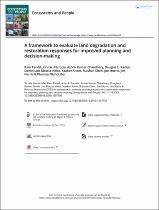 ResearchSpace
ResearchSpace
A framework to evaluate land degradation and restoration responses for improved planning and decision-making
JavaScript is disabled for your browser. Some features of this site may not work without it.
- ResearchSpace
- →
- Research Publications/Outputs
- →
- Journal Articles
- →
- View Item
| dc.contributor.author |
Pandit, R

|
|
| dc.contributor.author |
Parrotta, JA

|
|
| dc.contributor.author |
Chaudhary, AK

|
|
| dc.contributor.author |
Karlen, DL

|
|
| dc.contributor.author |
Vieira, DLM

|
|
| dc.contributor.author |
Anker, Y

|
|
| dc.contributor.author |
Chen, R

|
|
| dc.contributor.author |
Morris, J

|
|
| dc.contributor.author |
Harris, J

|
|
| dc.contributor.author |
Ntshotsho, Phumza

|
|
| dc.date.accessioned | 2020-03-19T10:54:50Z | |
| dc.date.available | 2020-03-19T10:54:50Z | |
| dc.date.issued | 2019-12 | |
| dc.identifier.citation | Pandit R. et al. 2019. A framework to evaluate land degradation and restoration responses for improved planning and decision-making. Ecosystems and People, vol. 16, no. 1, pp. 1-18 | en_US |
| dc.identifier.issn | 2639-5916 | |
| dc.identifier.uri | https://doi.org/10.1080/26395916.2019.1697756 | |
| dc.identifier.uri | https://www.tandfonline.com/doi/full/10.1080/26395916.2019.1697756 | |
| dc.identifier.uri | http://hdl.handle.net/10204/11361 | |
| dc.description | Copyright 2019 The Authors. This is an open access article under the terms of the Creative Commons Attribution License, which permits use, distribution and reproduction in any medium, provided the original work is properly cited. | en_US |
| dc.description.abstract | Avoiding, reducing or reversing land degradation will require increased restoration investments, carefully targeted and implemented to maximize environmental, economic and social benefits. Our objective was to develop a multi-criteria framework to assess effectiveness of land degradation responses for enhanced land use planning and restoration by evaluating both direct biophysical and socio-economic responses and indirect effects of various restoration strategies. The effectiveness of restoration responses is demonstrated for degraded forestland using a comprehensive literature review and case study in Nepal. The results show that most forestland restoration responses have an ecological focus with tree planting being the dominant direct response and economic and financial instruments the indirect responses. The results confirmed that environmental desirability was the dominant factor and economic feasibility was secondary for assessing restoration responses. Cultural acceptability was given the least consideration. Among sub-criteria, improved vegetative structure was the dominant restoration response. This study, originating from the Land Degradation and Restoration Assessment of the Intergovernmental Science-Policy Platform on Biodiversity and Ecosystem Services, supports the view that the scientific community and decision-makers must give greater attention to cultural, social, technical, and political dimensions that influence the outcomes of restoration responses to solve the pervasive problem of land degradation. | en_US |
| dc.language.iso | en | en_US |
| dc.publisher | Taylor & Francis Online | en_US |
| dc.relation.ispartofseries | Workflow;23269 | |
| dc.subject | Community forestry | en_US |
| dc.subject | Restoration outcomes | en_US |
| dc.subject | Forestland | en_US |
| dc.title | A framework to evaluate land degradation and restoration responses for improved planning and decision-making | en_US |
| dc.type | Article | en_US |
| dc.identifier.apacitation | Pandit, R., Parrotta, J., Chaudhary, A., Karlen, D., Vieira, D., Anker, Y., ... Ntshotsho, P. (2019). A framework to evaluate land degradation and restoration responses for improved planning and decision-making. http://hdl.handle.net/10204/11361 | en_ZA |
| dc.identifier.chicagocitation | Pandit, R, JA Parrotta, AK Chaudhary, DL Karlen, DLM Vieira, Y Anker, R Chen, J Morris, J Harris, and Phumza Ntshotsho "A framework to evaluate land degradation and restoration responses for improved planning and decision-making." (2019) http://hdl.handle.net/10204/11361 | en_ZA |
| dc.identifier.vancouvercitation | Pandit R, Parrotta J, Chaudhary A, Karlen D, Vieira D, Anker Y, et al. A framework to evaluate land degradation and restoration responses for improved planning and decision-making. 2019; http://hdl.handle.net/10204/11361. | en_ZA |
| dc.identifier.ris | TY - Article AU - Pandit, R AU - Parrotta, JA AU - Chaudhary, AK AU - Karlen, DL AU - Vieira, DLM AU - Anker, Y AU - Chen, R AU - Morris, J AU - Harris, J AU - Ntshotsho, Phumza AB - Avoiding, reducing or reversing land degradation will require increased restoration investments, carefully targeted and implemented to maximize environmental, economic and social benefits. Our objective was to develop a multi-criteria framework to assess effectiveness of land degradation responses for enhanced land use planning and restoration by evaluating both direct biophysical and socio-economic responses and indirect effects of various restoration strategies. The effectiveness of restoration responses is demonstrated for degraded forestland using a comprehensive literature review and case study in Nepal. The results show that most forestland restoration responses have an ecological focus with tree planting being the dominant direct response and economic and financial instruments the indirect responses. The results confirmed that environmental desirability was the dominant factor and economic feasibility was secondary for assessing restoration responses. Cultural acceptability was given the least consideration. Among sub-criteria, improved vegetative structure was the dominant restoration response. This study, originating from the Land Degradation and Restoration Assessment of the Intergovernmental Science-Policy Platform on Biodiversity and Ecosystem Services, supports the view that the scientific community and decision-makers must give greater attention to cultural, social, technical, and political dimensions that influence the outcomes of restoration responses to solve the pervasive problem of land degradation. DA - 2019-12 DB - ResearchSpace DP - CSIR KW - Community forestry KW - Restoration outcomes KW - Forestland LK - https://researchspace.csir.co.za PY - 2019 SM - 2639-5916 T1 - A framework to evaluate land degradation and restoration responses for improved planning and decision-making TI - A framework to evaluate land degradation and restoration responses for improved planning and decision-making UR - http://hdl.handle.net/10204/11361 ER - | en_ZA |





